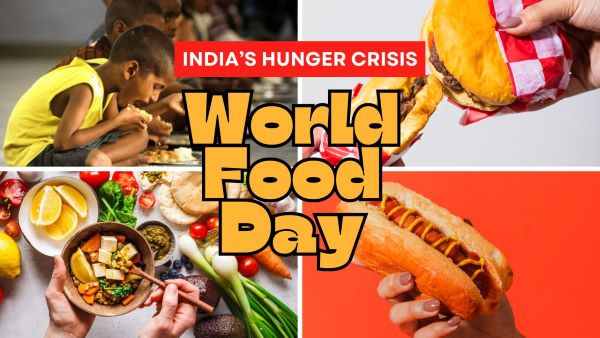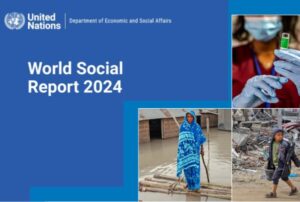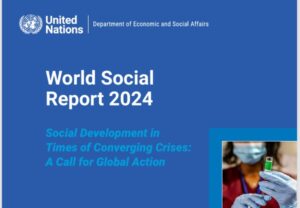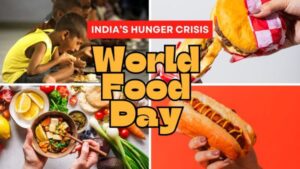World Food Day 2024: India’s Hunger Crisis and the Path Forward

Every year on October 16th, the world comes together to observe World Food Day. This day, established by the United Nations’ Food and Agriculture Organization (FAO), aims to raise awareness about global hunger and promote efforts toward food security and nutrition for all. In 2024, the theme of World Food Day is “Right to Food for a Better Life and a Better Future”
While the world has made significant strides in reducing hunger over the past decades, hunger continues to be a persistent challenge in many parts of the world, including India. According to the Global Hunger Index (GHI) 2024, India ranks 105th out of 127 countries, indicating serious levels of hunger and undernutrition. The country’s GHI score stands at 27.3, which places India in the “serious” hunger category
The Global Hunger Index 2024: Key Indicators for India
The GHI is a tool that tracks hunger globally by combining four key indicators:
Undernourishment: The proportion of the population that lacks sufficient caloric intake.
Child stunting: The percentage of children under five whose growth is impaired due to malnutrition.
Child wasting: The proportion of children under five who have low weight for their height.
Child mortality: The mortality rate of children under five, often linked to hunger and poor nutrition.
In India, the 2024 GHI data presents a worrying picture:
- 13.7% of the population is undernourished, meaning millions of people are not receiving enough food to meet their daily energy needs
- 35.5% of children under five are stunted, indicating chronic undernutrition that hinders physical and cognitive development
- 18.7% of children under five suffer from wasting, which signals acute malnutrition
- The under-five mortality rate is 2.9%, with malnutrition being a significant factor in child deaths
Why Hunger Persists in India
India’s hunger crisis is multi-faceted. Despite being one of the largest producers of food in the world, significant disparities exist in access to food across regions and populations. The following are key reasons for the persistence of hunger and undernutrition:
Economic Inequality:
While India’s economy has grown substantially over the past few decades, the benefits have not been evenly distributed. A large portion of the population, especially in rural areas, continues to live in poverty. This economic disparity directly impacts food access and quality, especially among marginalized groups like women and children.
Food Distribution Inefficiencies:
India has several food distribution programs, such as the Public Distribution System (PDS) and the National Food Security Act (NFSA). However, inefficiencies in these systems, such as corruption, delays, and inadequate coverage, prevent food from reaching all those in need. In many cases, food that is meant for the poor either spoils due to lack of storage infrastructure or gets diverted elsewhere.
Climate Change:
Agriculture, which employs more than half of India’s population, is highly dependent on the monsoon. Climate change has made rainfall patterns increasingly erratic, causing frequent droughts and floods that damage crops. This not only affects food production but also drives farmers into debt, exacerbating the hunger crisis.
Gender Inequality:
Women and girls are particularly vulnerable to malnutrition due to gender-based disparities in access to resources like healthcare and education. In many rural households, women eat last and least, leading to poor nutrition among women, which then contributes to poor maternal and child health.
Government Efforts to Combat Hunger
The Indian government has implemented several schemes to address food security and malnutrition. Some key initiatives include:
Midday Meal Scheme:
This program provides free meals to children in government schools, helping to ensure that children from low-income families receive at least one nutritious meal a day. It has significantly improved school enrollment and attendance, as well as child nutrition levels.
Integrated Child Development Services (ICDS):
Launched in 1975, this program aims to provide food, preschool education, and primary healthcare to children under six years of age and their mothers. It plays a vital role in reducing child malnutrition by offering supplementary nutrition and healthcare services to pregnant women, lactating mothers, and children.
POSHAN Abhiyaan (National Nutrition Mission):
Launched in 2018, this mission focuses on improving nutritional outcomes for children, pregnant women, and lactating mothers by addressing malnutrition through multi-sectoral interventions. The program includes community-based monitoring, capacity building, and the use of technology to track and improve nutrition levels.
Pradhan Mantri Garib Kalyan Anna Yojana (PMGKAY):
During the COVID-19 pandemic, the government introduced this scheme to provide free food grains to over 800 million people across India. This program has been extended several times to support vulnerable populations during economic downturns and disruptions caused by the pandemic.
The Road Ahead: How India Can Improve Its GHI Score
While India has made progress in some areas, much remains to be done. Here are some steps the country can take to improve its GHI score and tackle hunger more effectively:
Strengthen Food Distribution Systems:
Ensuring that food distribution schemes like PDS reach the most vulnerable sections of society without leaks and delays is essential. Leveraging technology to track food supplies and deliveries can help reduce inefficiencies and corruption in the system.
Address Agricultural Challenges:
Promoting sustainable agricultural practices and providing adequate support to farmers can help mitigate the impact of climate change on food production. Investing in water conservation techniques, drought-resistant crops, and improving irrigation infrastructure are crucial steps in this direction.
Focus on Maternal and Child Nutrition:
Improving the nutritional status of women, especially pregnant and lactating mothers, can have a direct impact on reducing child malnutrition. Ensuring access to healthcare and educating communities about the importance of nutrition can help break the cycle of malnutrition.
Reduce Food Waste:
India wastes a significant amount of food each year due to inadequate storage facilities and poor post-harvest management. Building cold storage chains and improving infrastructure in rural areas can help preserve food and reduce wastage.
Empower Women and Marginalized Communities:
Addressing the social and economic barriers that prevent women and marginalized groups from accessing nutritious food is critical. Empowering women through education, financial inclusion, and equal access to resources can lead to better nutrition outcomes for entire families.
Conclusion
On World Food Day 2024, the spotlight is on the urgent need for countries like India to take bold and coordinated actions to ensure that hunger becomes a thing of the past. With a focused approach on sustainable agriculture, efficient food distribution, and improving maternal and child health, India can make strides toward food security for all its citizens. Ending hunger is not just about producing more food but ensuring that every individual has equal access to safe, nutritious, and sufficient food.
The Global Hunger Index serves as a stark reminder of the work that still needs to be done, and India’s journey toward achieving zero hunger is ongoing.





